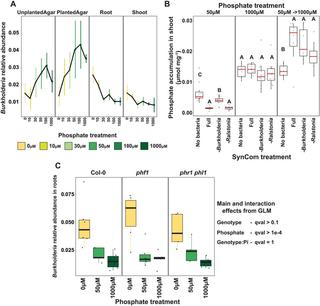当前位置:
X-MOL 学术
›
PLOS Biol.
›
论文详情
Our official English website, www.x-mol.net, welcomes your feedback! (Note: you will need to create a separate account there.)
The effects of soil phosphorus content on plant microbiota are driven by the plant phosphate starvation response.
PLOS Biology ( IF 9.8 ) Pub Date : 2019-11-13 , DOI: 10.1371/journal.pbio.3000534 Omri M Finkel 1, 2 , Isai Salas-González 1, 2, 3 , Gabriel Castrillo 1 , Stijn Spaepen 4 , Theresa F Law 1, 2 , Paulo José Pereira Lima Teixeira 1, 2 , Corbin D Jones 1, 3, 5, 6, 7, 8 , Jeffery L Dangl 1, 2, 3, 7, 8, 9
PLOS Biology ( IF 9.8 ) Pub Date : 2019-11-13 , DOI: 10.1371/journal.pbio.3000534 Omri M Finkel 1, 2 , Isai Salas-González 1, 2, 3 , Gabriel Castrillo 1 , Stijn Spaepen 4 , Theresa F Law 1, 2 , Paulo José Pereira Lima Teixeira 1, 2 , Corbin D Jones 1, 3, 5, 6, 7, 8 , Jeffery L Dangl 1, 2, 3, 7, 8, 9
Affiliation

|
Phosphate starvation response (PSR) in nonmycorrhizal plants comprises transcriptional reprogramming resulting in severe physiological changes to the roots and shoots and repression of plant immunity. Thus, plant-colonizing microorganisms-the plant microbiota-are exposed to direct influence by the soil's phosphorus (P) content itself as well as to the indirect effects of soil P on the microbial niches shaped by the plant. The individual contribution of these factors to plant microbiota assembly remains unknown. To disentangle these direct and indirect effects, we planted PSR-deficient Arabidopsis mutants in a long-term managed soil P gradient and compared the composition of their shoot and root microbiota to wild-type plants across different P concentrations. PSR-deficiency had a larger effect on the composition of both bacterial and fungal plant-associated microbiota than soil P concentrations in both roots and shoots. To dissect plant-microbe interactions under variable P conditions, we conducted a microbiota reconstitution experiment. Using a 185-member bacterial synthetic community (SynCom) across a wide P concentration gradient in an agar matrix, we demonstrated a shift in the effect of bacteria on the plant from a neutral or positive interaction to a negative one, as measured by rosette size. This phenotypic shift was accompanied by changes in microbiota composition: the genus Burkholderia was specifically enriched in plant tissue under P starvation. Through a community drop-out experiment, we demonstrated that in the absence of Burkholderia from the SynCom, plant shoots accumulated higher ortophosphate (Pi) levels than shoots colonized with the full SynCom but only under Pi starvation conditions. Therefore, Pi-stressed plants are susceptible to colonization by latent opportunistic competitors found within their microbiome, thus exacerbating the plant's Pi starvation.
中文翻译:

土壤磷含量对植物微生物群的影响是由植物磷酸盐饥饿反应驱动的。
非菌根植物中的磷酸盐饥饿反应(PSR)包括转录重编程,导致根和芽发生严重的生理变化并抑制植物免疫力。因此,植物定殖的微生物——植物微生物群——受到土壤磷(P)含量本身的直接影响,以及土壤磷对植物形成的微生物生态位的间接影响。这些因素对植物微生物群组装的个体贡献仍然未知。为了阐明这些直接和间接影响,我们在长期管理的土壤磷梯度中种植了 PSR 缺陷的拟南芥突变体,并将其芽和根微生物群的组成与不同磷浓度下的野生型植物进行了比较。PSR 缺乏对植物相关细菌和真菌微生物群组成的影响比对根和芽中土壤磷浓度的影响更大。为了剖析可变磷条件下植物与微生物的相互作用,我们进行了微生物群重建实验。通过在琼脂基质中使用具有宽磷浓度梯度的 185 个成员的细菌合成群落 (SynCom),我们证明了细菌对植物的影响从中性或正相互作用转变为负相互作用(通过花结大小来衡量) 。这种表型转变伴随着微生物群组成的变化:在磷饥饿下,伯克霍尔德氏菌属在植物组织中特别富集。通过群落脱落实验,我们证明,在没有来自 SynCom 的伯克霍尔德氏菌的情况下,植物芽比完全 SynCom 定殖的植物芽积累了更高的正磷酸盐 (Pi) 水平,但仅在 Pi 饥饿条件下。因此,Pi胁迫下的植物很容易被微生物组中发现的潜在机会竞争者定植,从而加剧植物的Pi饥饿。
更新日期:2019-12-03
中文翻译:

土壤磷含量对植物微生物群的影响是由植物磷酸盐饥饿反应驱动的。
非菌根植物中的磷酸盐饥饿反应(PSR)包括转录重编程,导致根和芽发生严重的生理变化并抑制植物免疫力。因此,植物定殖的微生物——植物微生物群——受到土壤磷(P)含量本身的直接影响,以及土壤磷对植物形成的微生物生态位的间接影响。这些因素对植物微生物群组装的个体贡献仍然未知。为了阐明这些直接和间接影响,我们在长期管理的土壤磷梯度中种植了 PSR 缺陷的拟南芥突变体,并将其芽和根微生物群的组成与不同磷浓度下的野生型植物进行了比较。PSR 缺乏对植物相关细菌和真菌微生物群组成的影响比对根和芽中土壤磷浓度的影响更大。为了剖析可变磷条件下植物与微生物的相互作用,我们进行了微生物群重建实验。通过在琼脂基质中使用具有宽磷浓度梯度的 185 个成员的细菌合成群落 (SynCom),我们证明了细菌对植物的影响从中性或正相互作用转变为负相互作用(通过花结大小来衡量) 。这种表型转变伴随着微生物群组成的变化:在磷饥饿下,伯克霍尔德氏菌属在植物组织中特别富集。通过群落脱落实验,我们证明,在没有来自 SynCom 的伯克霍尔德氏菌的情况下,植物芽比完全 SynCom 定殖的植物芽积累了更高的正磷酸盐 (Pi) 水平,但仅在 Pi 饥饿条件下。因此,Pi胁迫下的植物很容易被微生物组中发现的潜在机会竞争者定植,从而加剧植物的Pi饥饿。


























 京公网安备 11010802027423号
京公网安备 11010802027423号